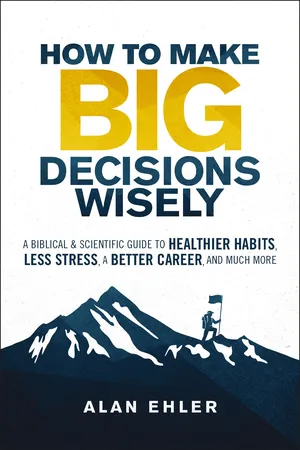
How to Make Big Decisions Wisely
A Biblical and Scientific Guide to Healthier Habits, Less Stress, A Better Career, and Much More
- 208 pages
- English
- ePUB (mobile friendly)
- Available on iOS & Android
How to Make Big Decisions Wisely
A Biblical and Scientific Guide to Healthier Habits, Less Stress, A Better Career, and Much More
About this book
Our decisions determine our lives. Invest in a company that goes bankrupt and you lose your life savings. Say the wrong thing in an interview and you miss the job of the lifetime. Make no decisions and you miss every opportunity. In today's rapidly changing world, the cost of poor decisions (and no decisions) is higher than ever.
In How to Make Good Decisions Wisely, author and scholar Alan Ehler lays out a clear approach to making big decisions based on the Bible and recent discoveries in neuroscience and decision science. He presents a simple, four-step process that can be followed to make any kind of decision, whether personal, professional, or relational.
Making big decisions can rewrite lives, careers, families, churches, and businesses. A lot is at stake. Learn how to choose well.
Frequently asked questions
- Essential is ideal for learners and professionals who enjoy exploring a wide range of subjects. Access the Essential Library with 800,000+ trusted titles and best-sellers across business, personal growth, and the humanities. Includes unlimited reading time and Standard Read Aloud voice.
- Complete: Perfect for advanced learners and researchers needing full, unrestricted access. Unlock 1.4M+ books across hundreds of subjects, including academic and specialized titles. The Complete Plan also includes advanced features like Premium Read Aloud and Research Assistant.
Please note we cannot support devices running on iOS 13 and Android 7 or earlier. Learn more about using the app.
Information
Table of contents
- Cover Page
- Title Page
- Copyright Page
- Dedication
- Contents
- Foreword
- Acknowledgments
- Part 1: Choosing Well
- Part 2: Story-Shaping Steps
- Part 3: What Story Shaping Looks Like
- Notes
- Bibliography